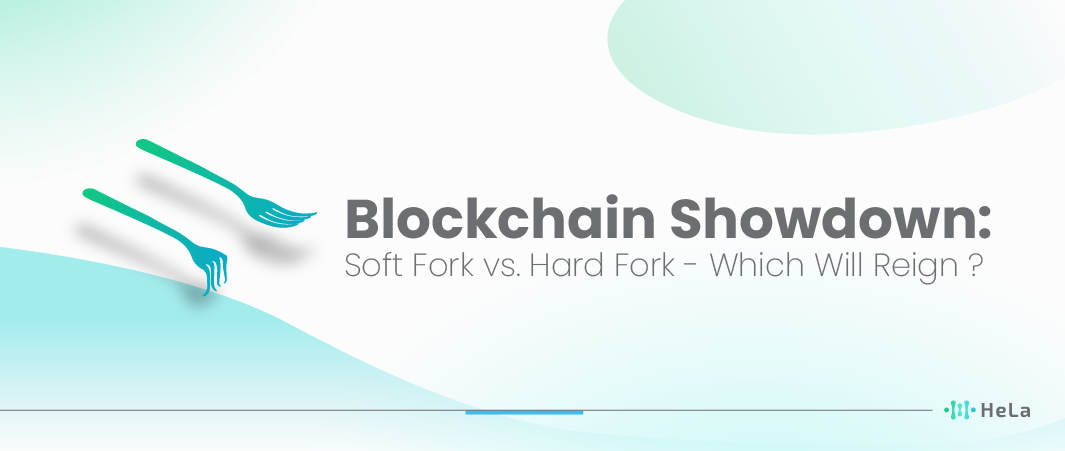In the realm of blockchain technology, the terminologies “soft fork” and “hard fork” have emerged as focal points of many debates and discussions. As the blockchain landscape continuously evolves, understanding these terminologies becomes crucial for anyone invested or interested in the field. This article will provide a comprehensive comparison of soft forks versus hard forks, highlighting their distinct characteristics, implications, and the potential challenges each one might bring to the table.
The concept of a “fork” in blockchain relates to changes or modifications in the existing code of a cryptocurrency. These changes can be minor or major, leading to either a soft fork or a hard fork, respectively. By delving deeper into their intricacies, one can better appreciate the robust nature of blockchain technology and the need for adaptability within its framework.
To simplify, imagine blockchain as a book series. If one book suddenly changes its storyline but still fits into the series, it’s akin to a soft fork. But if a book diverges entirely, starting a new series altogether, that’s more like a hard fork. This analogy, while elementary, paves the way for our detailed exploration below.
The Nature of Forks in Blockchain

Blockchain networks operate based on a set of predefined rules, which we call protocols. These rules lay down the groundwork for validating transactions and adding new blocks to the chain, among other things. Sometimes, there arises a need to update these protocols, whether it’s to enhance security, improve functionality, or address other concerns. This is where hard fork vs soft fork comes into play.
When updates to blockchain protocols are required, they can lead to the creation of forks. Hard forks and soft forks are the two main categories of these updates. A hard fork represents a significant change in the rules, often resulting in a split where the new blockchain operates separately from the old one. On the other hand, a soft fork introduces more minor adjustments that maintain compatibility with the previous rules.
Also Read: Blockchain Adoption: Transforming Industries for a Digital Future
So, in essence, the nature of forks in blockchain is all about adapting and evolving these underlying protocols, with hard forks and soft forks being the primary ways this evolution occurs, each catering to different degrees of change.
What is a Soft Fork?
A soft fork is like a software update for a blockchain network that’s designed to be user-friendly and inclusive. It’s kinda like when you’re watching a 3D movie with those old-school 3D glasses – even if you don’t get the fancy new glasses, you can still watch the movie, but you won’t experience the full 3D effect. In the world of blockchain, this means you can keep using the network without upgrading, but there might be some limitations on what you can do.
Now, let’s talk about the difference between a hard fork and a soft fork. A hard fork is like splitting the road into two separate paths – if you don’t choose the new path, you can’t go where everyone else is headed. It’s a bit disruptive because the old and new paths don’t work together. On the other hand, a soft fork is more like adding a new lane to the road, but the old lanes still work for those who don’t want to use the new one. It’s smoother and doesn’t force everyone to change at once.
Soft forks are usually used for minor updates or fixing bugs, and they’re successful when most miners agree to follow the new rules. Over time, as more people switch to the new version, the old one naturally fades away. So, in the world of blockchain, soft forks are all about making changes without causing too much chaos.
Understanding a Hard Fork

A hard fork, unlike a soft fork, makes changes to a blockchain that can’t easily coexist with the old version. Imagine you’re reading a book series, and suddenly the story takes a completely different path. To keep following the story, everyone reading must switch to this new narrative or stick with the original one. This is where the hard fork vs soft fork comparison comes in handy.
Now, when a hard fork occurs, it can lead to the creation of two separate blockchains if there isn’t a unanimous agreement among the network participants about the changes. This is akin to a situation where some readers decide to follow the new storyline, while others prefer the original plot. For instance, Bitcoin Cash emerged as a new cryptocurrency from a hard fork of the original Bitcoin due to differences in vision and objectives among the community and developers.
The reasons for hard forks can vary widely, from implementing major protocol upgrades to disagreements among developers or varying community goals. Essentially, it’s like a turning point in the series where readers must decide whether they’re in for the new adventure or sticking to the familiar journey. This hard fork vs soft fork distinction is crucial in understanding how blockchain networks evolve and adapt over time.
Implications and Challenges of Forks
When it comes to making changes in a blockchain network, whether it’s a hard fork vs soft fork, there are some important implications and challenges to consider:
Soft Forks
- Soft forks are usually less disruptive and aim to implement new rules that are backward-compatible with the existing blockchain. Nevertheless, they present a unique array of difficulties.
- These upgrades rely on a majority of network participants to adopt the new rules promptly, which can be a bit of a gamble. If not everyone upgrades in time, temporary forks in the blockchain can occur. This can lead to confusion and potential transactional problems.
- The main challenge with soft forks is ensuring widespread consensus and swift adoption of the new rules to avoid network fragmentation.
Hard Forks
- In contrast, hard forks can result in more significant changes to the blockchain, potentially leading to community splits among users and developers. This is a crucial aspect of the hard fork vs soft fork debate.
- The split in the community can be problematic as it divides resources and can lead to reduced security if miners are spread across both versions of the blockchain.
- Furthermore, hard forks can give rise to a new cryptocurrency, impacting the value of both the original coin and its offshoot. This can lead to market volatility, which can be challenging for investors and users to navigate.
Whether it’s a hard fork vs soft fork, blockchain upgrades come with their unique challenges. Soft forks demand consensus and prompt adoption, while hard forks can lead to community divisions and market instability. Balancing these factors is crucial for the smooth evolution of blockchain networks.
Difference of Hard Forks Vs. Soft Forks

Distinguishing between hard forks and soft forks can be instrumental in understanding their impact on a blockchain. Here’s a comparison to differentiate the two:
Compatibility
In the world of cryptocurrencies, there’s a significant difference between hard fork vs soft fork. A soft fork is like a software update that’s backward compatible, meaning older nodes can keep running on the existing rules but with some limitations. It’s a bit like using an older version of an app that still functions but lacks new features. On the other hand, a hard fork is not backward compatible, requiring all nodes to upgrade to the new rules to continue participating in the network. Think of it as everyone needing to switch to a completely new version of a social media platform to interact with others, leaving the old version behind.
Consensus
When it comes to making changes in a blockchain network, there are two main approaches: hard fork vs soft fork. A soft fork needs most people to agree with the changes before they become official, and once that majority is reached, the new rules become the norm. On the other hand, a hard fork requires everyone in the network to come to a unanimous decision to adopt the new rules, or else they risk ending up on a completely different and incompatible blockchain. So, it’s like deciding on a new path for the blockchain – with a soft fork, you need a strong majority to walk that path, while a hard fork demands that everyone takes the same step together.
Resultant Blockchains
In the world of blockchain technology, when it comes to making changes or updates, there are two main ways it happens: hard fork vs soft fork. A soft fork usually occurs when the blockchain community agrees on some changes, and the older versions of the blockchain gradually fade away as everyone adopts the new rules. However, a hard fork is a bit more dramatic – it can split the blockchain into two separate ones if there isn’t complete agreement among the users. So, while a soft fork leads to one dominant blockchain, a hard fork can result in two distinct blockchains going their separate ways.
Reasons for Implementation
Hard fork vs soft fork: When it comes to making changes to a blockchain, there are two main methods, each with its own purpose. A soft fork is like a software update, usually used for minor tweaks, fixing bugs, or making small adjustments that don’t drastically change how the blockchain works. On the other hand, a hard fork is a more substantial and sometimes contentious process, often triggered by the need for major improvements or when there are significant disagreements within the blockchain community, leading to substantial alterations in the protocol.
Community Impact
In the world of cryptocurrencies, when it comes to making changes to the underlying technology, there’s a fundamental difference between hard fork vs soft fork. A soft fork is typically less contentious, as it requires the majority of the community to adopt the changes for the network to function smoothly. On the other hand, a hard fork can be more divisive, often causing rifts among both users and developers, and sometimes even resulting in the creation of an entirely new cryptocurrency. So, in essence, these two approaches represent contrasting paths for evolving blockchain systems, with soft forks aiming for a more harmonious transition and hard forks often sparking debates and potential splits in the community.
Also Read: What is Layer 1? Definition and How does it work
Examples
When it comes to making changes to cryptocurrencies like Bitcoin or Ethereum, there are two main ways to do it: hard fork vs soft fork. A soft fork, like Bitcoin’s Segregated Witness (SegWit) update, is a more subtle change that’s backward-compatible with the existing system. It doesn’t split the community or create a new currency. On the other hand, a hard fork, like the ones that led to the creation of Ethereum Classic and Bitcoin Cash, is a more significant change. It creates a whole new blockchain, essentially splitting the original community into two, each with its own separate currency. So, soft forks are like gentle upgrades, while hard forks are like branching off into a new direction.
This side-by-side comparison elucidates the nuanced differences and potential implications of both soft and hard forks in the blockchain arena.
Conclusion
The decision between implementing a soft fork or a hard fork is a pivotal one in the blockchain world. Each comes with its own merits and potential drawbacks. Understanding the nature, implications, and challenges of these forks is crucial for developers, investors, and users alike. As blockchain continues to be a transformative force in the digital world, the dynamics of forks will undeniably play a central role in shaping its future.
Furthermore, it’s essential for stakeholders to engage in informed discussions about potential forks. This not only ensures the continuous evolution and betterment of blockchain protocols but also upholds the decentralized ethos that is at the core of this revolutionary technology.
Lastly, as with any transformative technology, adaptability remains key. The blockchain landscape will continue to shift, and forks, whether soft or hard, are a testament to the technology’s ability to evolve and meet the changing needs of its user base. In this ever-evolving scenario, knowledge and adaptability are the anchors that will drive the future of blockchain technology.
Disclaimer: The information provided by HeLa Labs in this article is intended for general informational purposes and does not reflect the company’s opinion. It is not intended as investment advice or recommendations. Readers are strongly advised to conduct their own thorough research and consult with a qualified financial advisor before making any financial decisions.

I am Carina Caringal, a technical writer specializing in blockchain engineering concepts, decentralized systems, crypto infrastructure, and Web3 technologies. My work focuses on analyzing and translating complex technical mechanisms into precise, structured, and insightful content for both developers and non-technical readers who want a deeper understanding of the decentralized ecosystem.
My background in blockchain and cryptocurrency is rooted in years of independent research, continuous learning, and hands-on exploration across multiple protocols and network architectures. I study the underlying mechanics of distributed ledger technology, from consensus algorithms and smart contract logic to network scalability, security models, cryptographic principles, and interoperability frameworks. This technical foundation shapes the way I approach every article, ensuring accuracy, depth, and relevance.
- Carina Caringalhttps://helalabs.com/blog/author/carina-caringal/
- Carina Caringalhttps://helalabs.com/blog/author/carina-caringal/
- Carina Caringalhttps://helalabs.com/blog/author/carina-caringal/
- Carina Caringalhttps://helalabs.com/blog/author/carina-caringal/

